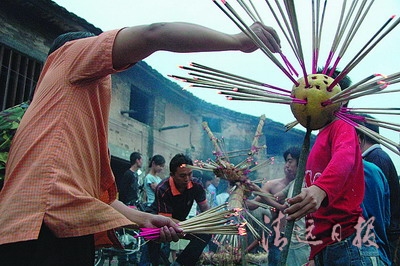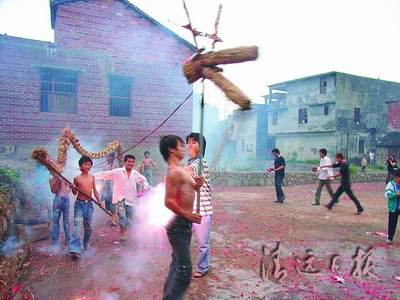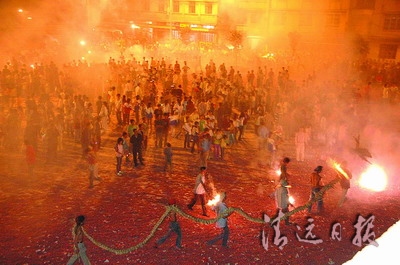With a history dating back more than 170 years, the incense dragon dancing is a popular folk custom in Chadong and Zhengqi villages near Lianzhou city. In the past, whenever pests attacked crops, or an epidemic broke out among poultry or livestock, farmers believed that the god of plagues was making trouble. To exorcise this malfeasant spirit, villagers would request the help of other deities, praying to them for good weather, healthy livestock, bumper harvests and peace by performing incense dragon dances. Held generation after generation, the dances have evolved into an annual traditional activity held during the Spring Festival.
During the Spring Festival, villagers will hold an inauguration ceremony in front of the village temple, bringing incense, candles and offerings including a chicken. After the chicken has been killed, liquor is sprinkled around, candles and joss paper are burned and burning incense is placed on the “incense dragon”.
Shaped like the dragons of legends, the incense dragon consists of a dragon’s head (one person), a dragon body (nine sections held up by nine persons) and a dragon’s tail (one person) and is more than 20 meters long. Burning incense sticks are inserted all over the dragon’s body, which in the darkness of night illuminates it, giving it its name. The people in Hedong town make incense dragons with ferns collected from the mountains. Once dried in the sun, the ferns can be tied up tightly, making them perfect for inserting incense into. During performances, a strong young man will hold the dragon head high, and another dancer, holding a ball, will play with the dragon. Five people lead the incense dragon, holding up five dragon lamps (three round and two rectangular), to form the shape of a “straight line, a "herring bone” and other shapes. With another five gong and drum players, the whole troupe numbers around 20-30 people.
After the temple sacrifices, the villagers perform the incense dragon dance, accompanied by the music of gongs, drums and cymbals, in one village after another. When farmers know the incense dragon is approaching, they will wait at home until he has entered the village. As the incense dragon arrives, they will devoutly pull out a handful of incense sticks from his body, insert them into the doorway or the family shrine, and pray that the incense dragon will bring them good luck. After that they will insert a different bundle of burning incense into the dragon’s body as an act of worship. In this way, the incense on the incense dragon is continually burning. The dragon dance troupe will then perform an incense dragon dance in an open space for the villagers, to convince them that the incense dragon will bring blessings and luck and drive away plagues. After the performance in one village is over, the troupe will go on to the next. Sometimes the work of the dancers will continue from dusk until dawn.
At the break of dawn, the dancers stop dancing and place the dragon in an empty house. The next evening, their travels will continue until they have performed in all of the villages under their plans. With their task complete, the troupe will arrive at a riverside beach where they will set fire to the incense dragon, burning it down and letting the river water carry it away. They will also kill a chicken and place it in the river alongside the ashes of the dragon. This marks the official end of the incense dragon dancing.
This traditional folk custom, along with many others, was once on the verge of disappearance. As a result in 1997, the people’s government of the autonomous county mobilized all towns and villages to salvage folk arts in the county. Through the personal teaching of the old artists Zhang Changming, Zhang Shan’an and Zhang Liangxing at Chadong village, the younger generation has come to learn and resume the practice. Their efforts were rewarded when they were given the prize of excellent organizer and excellent performer at the “Millennium Ancient Folk Art Performance” organized by the county. This time-honored folk art now has now been fully restored to its glory days.
 |
| “Decorating the dragon” with burning incenses. |
 |
|
The “Burning dragon” “burns” players with firecrackers.
|
 |
|
At the dragon farewell night, 11 dragons arrive in town, creating a bustling scene.
|
 |
|
The young dancers danced with boundless energy and came back again after applying some antiseptic dye over the burnt areas.
|